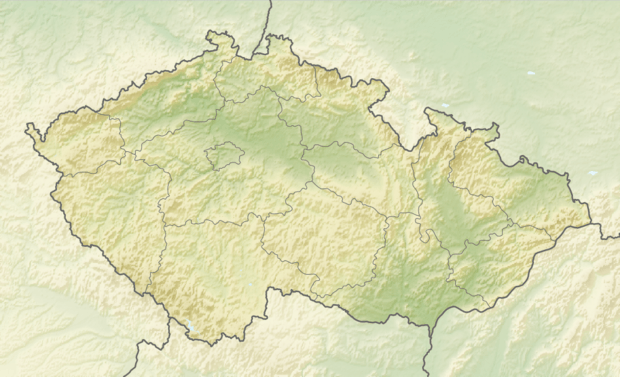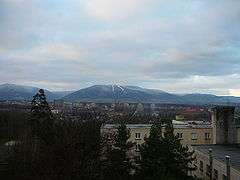Třinec
Třinec (Czech pronunciation: [ˈtr̝̊ɪnɛts] (![]()
![]()
Třinec Trzyniec | |
|---|---|
 T. G. Masaryk square in Třinec | |
 Flag  Coat of arms | |
 Třinec Location in the Czech Republic | |
| Coordinates: 49°40′40″N 18°40′22″E | |
| Country | |
| Region | |
| District | Frýdek-Místek |
| First mentioned | 1444 |
| Town rights | 1931 |
| Statutory city | 2018 |
| Town parts | |
| Government | |
| • Mayor | Věra Palkovská |
| Area | |
| • Total | 85.38 km2 (32.97 sq mi) |
| Elevation | 306 m (1,004 ft) |
| Population (2019-01-01[1]) | |
| • Total | 35,131 |
| • Density | 410/km2 (1,100/sq mi) |
| Time zone | UTC+1 (CET) |
| • Summer (DST) | UTC+2 (CEST) |
| Postal code | 738 01 to 739 94 |
| Website | www.trinecko.cz |
Třinec is also an important cultural center of the Polish minority in Zaolzie.
Etymology
The name Třinec is of topographic origin, derived from the Polish word for reed (Polish: trzcina, locally trzena // trzyna, strzena, trzcena).[3]
History
The village of Třinec was founded in the 14th century and first mentioned in 1461, when a person z [from] Trencze was attested to.[3][4] Politically, the village then belonged to the Duchy of Teschen, a fee of the Kingdom of Bohemia, which after 1526 became part of the Habsburg Monarchy.
The majority of the population worked in agriculture. The area was, however, rich in limestone, iron ore, and clay. The region also offered a large enough workforce, so it was decided to build an iron works there. In 1836, construction of the first metallurgical furnace had begun. The iron mill began operation in 1839, becoming the largest in the entire Cieszyn Silesia. The first schools (Polish-German) in Třinec were opened by the initiative of the iron works in 1851. After the construction of the Košice-Bohumín Railway line in 1871, rapid development of the town took place.
After the revolutions of 1848 in the Austrian Empire, a modern municipal division was introduced in the re-established Austrian Silesia. The village as a municipality was added to the political and legal district of Cieszyn. According to the censuses conducted in 1880, 1890, 1900, and 1910, the population of the municipality grew from 1,792 in 1880 to 3,849 in 1910, with a majority being native Polish-speakers (growing from 51.4% in 1880 to 96.6% in 1900 and 96% in 1910), accompanied by a German-speaking minority (at most 32.5% in 1880, then dropping to 12.2% in 1900 and up to 24.3% in 1910) and Czech-speakers (peaking in 1890 at 17.4%, then dropping to 6.7% in 1910). In terms of religion, in 1910 the majority were Roman Catholics (63.2%), followed by Protestants (34.5%), Jews (76 or 1.9%), and 13 people adhering to another faith.[5] The village was also traditionally inhabited by Cieszyn Vlachs, speaking the Cieszyn Silesian dialect.
After World War I, the fall of Austria-Hungary, the Polish–Czechoslovak War, and the division of Cieszyn Silesia in 1920, it became a part of Czechoslovakia. Třinec gained town rights in 1931. Following the Munich Agreement in October 1938, together with the Zaolzie region, it was annexed by Poland, administratively adjoined to Cieszyn County of the Silesian Voivodeship.[6] It was then annexed by Nazi Germany at the beginning of World War II. After the war, it was restored to Czechoslovakia.
In 1946, it was merged with the village of Lyžbice, where in the 1950s the ruling Communist Party of Czechoslovakia began large-scale development in the style of socialist realism. Afterwards, Lyžbice became a new downtown, taking the place of Staré Město (lit. Old Town).
Geography
The town of Třinec is located in the Moravian-Silesian Region in the north-east of the Czech Republic, very close to the Polish border and also near the Slovak border, with an elevation of approximately 300 m (984.25 ft) above sea level. It is situated approximately 45 km (28 mi) away from the city of Ostrava and about 320 km (199 mi) from the country's capital, Prague. The town is surrounded by the picturesque Beskydy mountain range, a popular place for cycling, skiing, cross-country skiing, hiking, and paragliding. The town itself comprises the main town built around the steel works but also incorporates a number of surrounding villages.

Music and culture
There are a number of musical concerts that take place in the town throughout the year. They are usually held at the local football stadium or the Třinecký Zimní Stadion sports arena, or alternatively at the Třinec-Borek football grounds. The year's biggest events are the 'Hutnický den', which takes place in May, and 'Noc Plná Hvězd' (Star-Studded Night) in the summer, both festivals which feature numerous live performances from bands and artists from all over the country and abroad. Another yearly event is the 'Zlot' concert in the nearby town of Bystřice, aimed at the local Polish population.
Sport
Ice hockey and football are by far the town's biggest sports. The ice hockey team, HC Oceláři Třinec, which currently plays in the Czech Extraliga, the top tier of Czech ice hockey, has a massive following and fan base in Třinec. The team holds a regional rivalry with Ostrava-based HC Vítkovice.
Oceláři (Steelers) play their home games at Werk Arena, which opened in 2014 and has a seating capacity of 5,200 and is often filled for big hockey games. The arena also hosted the Team Czech Republic at the 2016 Davis Cup World Group.
The town's football team, FK Fotbal Třinec, has seen a rise in popularity after its promotion to the Czech 2. Liga several years ago. Average attendance for league matches is now more than 1,000. A rivalry with neighbouring sides FC Vítkovice and MFK Karviná has also been established.
Třinec also has a popular athletics team.
Local dialect

Although the majority of the town's population speak Czech, a large number speaks in a Cieszyn Silesian dialect, a mixture of Czech, Polish, and German. The dialect is very specific to the whole region of Cieszyn Silesia.
People
- Albert Černý, singer, he represented the Czech Republic in the Eurovision Song Contest 2019 together with his band Lake Malawi.
- Lenka Cenková, tennis player
- Jana Cieslarová, orienteer
- Michaela Dolinová, Czech actress and TV presenter
- Ewa Farna, Polish-Czech singer
- Tomáš Klus, musician
- Tadeusz Kraus, football player
- Vojtěch Kučera, poet
- Edvard Lasota, Czech football player
- Eduard Ovčáček, lettrist, graphic artist, painter, and sculptor
- Soňa Pertlová, chess player
- Petr Pravec, astronomer
- Lukáš Rakowski, figure skater
- Roman Sikora, Czech playwright
- Martin Staszko, professional poker player
- Petr Šiška, TV presenter, musician, and songwriter
- Robert Šulgan, professional boxer
- Václav Svěrkoš, Czech football player
- David Szurman, Czech ice dancer
- Czeslaw Walek, lawyer and LGBT activist
- Petr Wojnar, football player
References
- "Population of municipalities of the Czech republic". Czech Statistical Office. Retrieved 30 April 2019.
- "2001 census data". Czech Statistical Office.
- Mrózek, Robert (1984). Nazwy miejscowe dawnego Śląska Cieszyńskiego [Local names of former Cieszyn Silesia] (in Polish). Katowice: Uniwersytet Śląski w Katowicach. p. 177. ISSN 0208-6336.
- Panic, Idzi (2010). Śląsk Cieszyński w średniowieczu (do 1528) [Cieszyn Silesia in Middle Ages (until 1528)] (in Polish). Cieszyn: Starostwo Powiatowe w Cieszynie. p. 313. ISBN 978-83-926929-3-5.
- Piątkowski, Kazimierz (1918). Stosunki narodowościowe w Księstwie Cieszyńskiem (in Polish). Cieszyn: Macierz Szkolna Księstwa Cieszyńskiego. pp. 265, 284.
- "Ustawa z dnia 27 października 1938 r. o podziale administracyjnym i tymczasowej organizacji administracji na obszarze Ziem Odzyskanych Śląska Cieszyńskiego". Dziennik Ustaw Śląskich (in Polish). Katowice. nr 18/1938, poz. 35. 31 October 1938. Retrieved 1 July 2014.
- "Partnerská města: Město Třinec" (in Czech). Statutární město Třinec. Retrieved 22 August 2019.
Further reading
- Cicha, Irena; Jaworski, Kazimierz; Ondraszek, Bronisław; Stalmach, Barbara; Stalmach, Jan (2000). Olza od pramene po ujście. Český Těšín: Region Silesia. ISBN 80-238-6081-X.
- Wawreczka, Henryk (2004). Třinec a okolí: včera a dnes. Třinec - Nebory: Wart. ISBN 80-239-3819-3.

